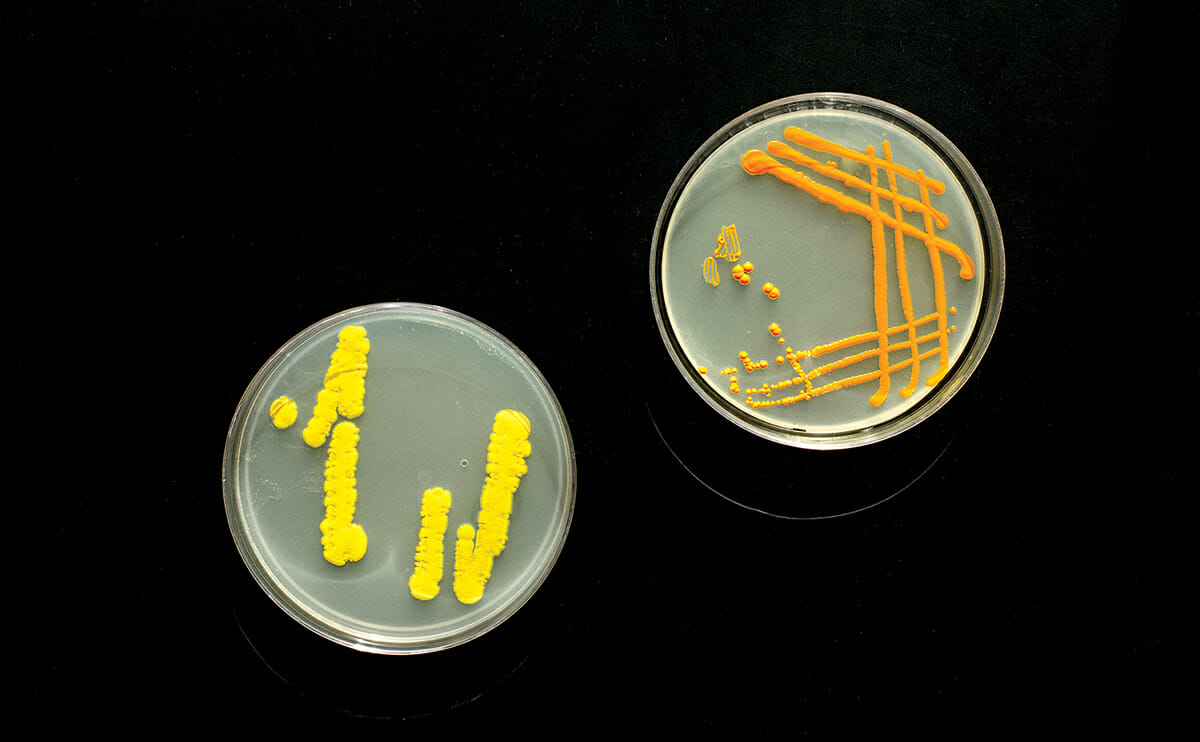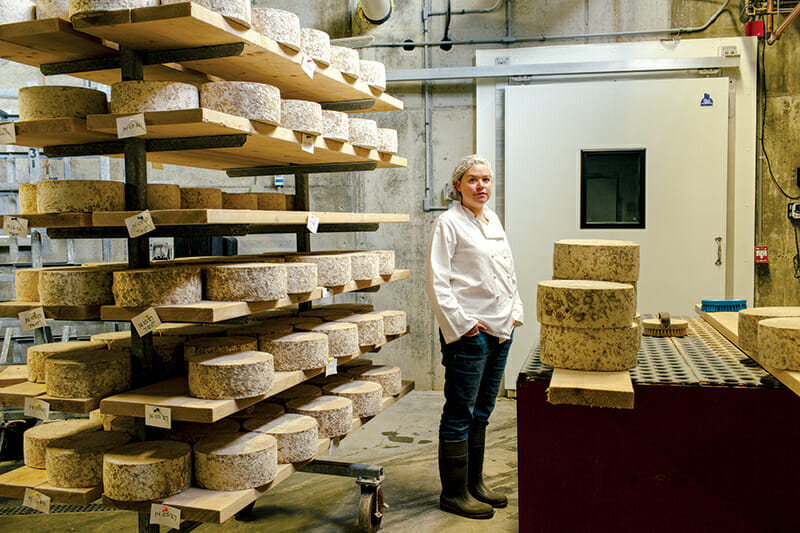How microbiology can make cheddar better.

In her white lab coat and sensible crocs, Sayer Dion Smyczek doesn’t look like a typical food revolutionary, but she is helping to upend the world of artisan cheesemaking.
For the past few months, Smyczek has worked as the nation’s first and only full-time microbiologist at the Cellars at Jasper Hill, a small creamery in northeastern Vermont. Although it sits above a cheese cellar, her state-of-the-art workspace would make any microbiologist feel at home.
Smyczek’s duties extend far beyond basic quality control and food safety, the typical concerns of microbiologists working with large producers. The way that microbes interact with cheese remains as mysterious to researchers as the first cells to emerge from Earth’s primordial soup. She intends to take a survey of the microbes that call these cheeses home and then employ them to create dairy masterpieces.
“Our goal,” says Mateo Kehler, who founded Jasper Hill Farm just over a decade ago with his brother, Andy, “is to elevate the quality and the character of our cheeses by understanding every aspect of their production, from soil science to what the cows eat to the microbes we use.”
[mf_1200px_image src=”https://modernfarmer.com/wp-content/uploads/2014/11/jasperhill.jpg” caption=”Jasper Hill Farm nestled among the rolling hills of Northern Vermont; Cows graze behind the farm.” captionposition=”none” parallax=”off”]
Making cheese has typically been more art than science, relying on trial and error to create the perfect taste and texture. With their high-tech microbiology lab, Jasper Hill is changing all of that. They are turning cheesemaking into a science, giving artisans a chance to harness microbes in order to nurture new flavors and textures.
Acids and chemical compounds create the texture, aroma and flavor of cheese. Without microbes, we’d all be eating Kraft Singles.
Nestled in the mountains of Vermont’s Northeast Kingdom, just outside the tiny town of Greensboro Bend, Jasper HIll is accessible only by rutted dirt roads, with no cell phone reception and plenty of open pasture for their resident cows. The creamery, which produces six varieties of cheese – and, in its cellars, ages six more from other small producers – looks, from the outside, to be a window into cheesemaking’s past. Each wheel is wiped, pressed and turned by hand, activities that have been delegated to machines at most other creameries. This labor-intensive process gives the cheese a unique flavor and is what Jasper Hill’s motto is all about: a taste of place.
This commitment to tradition wouldn’t seem to jibe with an on-site, high-tech microbiology lab, butmicrobes play a leading role in determining taste. “Cheese is basically a cluster of proteins and fats, which, left untouched, have very little flavor complexity,” says Andy Hatch, a cheesemaker at Uplands Cheese in Wisconsin. As the cheese ages, microbes convert these proteins and fats into amino and fatty acids. “It’s these acids, and chemical compounds related to them, which create the texture, aroma and flavor of a ripe cheese,” Hatch says. Simply put: Without microbes, we’d all be eating Kraft Singles.
Microbes play a central role in cheesemaking from the moment that cows start munching on grass. Bacteria in the cow’s rumen (the first section of its stomach) help to digest the plant material and determine the types of fats and proteins that appear in the milk. Other microbes feed on the milk and produce lactic acid, which coagulates the milk into curds, leaving watery whey behind. After the cheese is formed and pressed, the process of affinage, or finishing, begins. Each cheese develops its own specific mixture of yeast, mold and bacteria. This gives Jasper Hill’s cheeses a texture and flavor that is found nowhere else.
Smyczek, who originally planned to work as a forensic scientist, left the world of corpses after a stint helping to develop fermentation starters for beer brewers in San Diego. When she heard that Jasper Hill was looking for a full-time microbiologist, Smyczek knew it was a once-in-a-lifetime chance. She jumped at it.
[mf_mosaic_container columns=”2″ captions=”yes”]
[mf_mosaic_item src=”https://modernfarmer.com/wp-content/uploads/2014/11/cheese1.jpg” number=”1″ caption=”Jasper Hill employees wrap Harbison cheese in spruce.”]
[mf_mosaic_item src=”https://modernfarmer.com/wp-content/uploads/2014/11/cheese2.jpg” number=”2″ caption=”A pipette used to transfer liquid from one container to another in a sterile manner.”]
[mf_mosaic_item src=”https://modernfarmer.com/wp-content/uploads/2014/11/cheese3.jpg” number=”3″ caption=”Tests are run on milk in the lab.”]
[/mf_mosaic_container]
She began her work by identifying the microbes found both in the cheeses and around the creamery using fragments of DNA from each organism. A preliminary survey identified 192 species. Although many of the microbes found in the cheeses could be easily traced to environmental sources (the cows, the milking machines, the walls of the cellars), Smyczek couldn’t begin to guess where others came from. “They seem to have appeared out of nowhere,” she says.
Rachel Dutton, a cheese microbiologist at Harvard University, wasn’t surprised by the results of Smyczek’s survey. Dutton’s own work studying the microbes on cheese rinds from around the world confirmed just how little scientists know about the tiny crafters of some of our favorite foods.
“We knew microbes were there, but we still have no idea what draws them to the cheese and what they do once they’re there,” Dutton says. The symphony of flavor in each bite of cheese is played on unknown instruments directed by an invisible conductor.
[mf_mosaic_container columns=”2″ captions=”yes”]
[mf_mosaic_item src=”https://modernfarmer.com/wp-content/uploads/2014/11/microbio1.jpg” number=”1″ caption=”The spruce used to wrap the Harbison cheese is usually harvested from the grounds.”]
[mf_mosaic_item src=”https://modernfarmer.com/wp-content/uploads/2014/11/microbio2.jpg” number=”2″ caption=”A cow and its keeper get airborn in a barnside mural.”]
[/mf_mosaic_container]
Cracking this mystery is more than just solving a microbial whodunit to Smyczek. Once she’s established the microbes found in each type of cheese, she’ll study how each contributes to the flavor and texture, as well as how they work together. “You don’t act the same when you’re at home by yourself as when you have company over,” Smyczek says. “Microbes don’t either.” She is developing the means to study whole communities of microbes, which she’ll then be able to manipulate.
It sounds high-tech, but Smyczek hopes to use these ultra-modern tools to heighten and diversify flavors that have existed for ages. She also hopes to create new varieties that are custom-designed mixtures of milk and microbes. With Smyczek working in her second-floor lab, Jasper Hill is merging cheese’s high-tech future with its artisanal past.
Top: Bacteria in petri dishes at the Cellars at Jasper Hill. Scientists are only now starting to understand how microbes affect the taste and texture of cheese.
